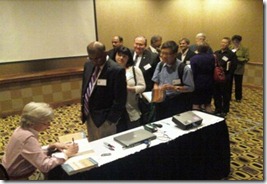The Chronicle of Higher Education Online had a piece on hiring that gave me pause. It tells the story of three candidates interviewing for a senior campus leadership position. Two played it safe and maintained distance from their audience with formal titles and podiums during their public forums. The third – who had tremendous support after a day of interviews and the strongest scholarly record among the three candidates – tried to demonstrate the values that would underpin her inclusive leadership style by suggesting more informality. Guess which two candidates were seen as real leaders?
[Skip to the text under the dotted line below if you want more case details before reading my comments.]
As a leadership scholar, I am struck by three things in the story. First, the power of the implicit leadership models we all carry – and how quickly and effortlessly they surface. If a candidate looks like what we think a leader should, acts like we think a leader would, then we must be seeing a leader, right? Maybe. Or we might be mindlessly projecting assumptions that have more to do with history and stereotypes than real leadership.
Second, our tacit models are often very traditional. In an increasingly complex, global world with serious challenges that we seem unable to resolve – war, poverty, violence, disease, oppression, threat of nuclear holocaust, destruction of the environment, and more – we need diverse ways of leading that capture collective wisdom and mobilize action like never before. Real leadership is about shared purpose and innovative problem solving, not blind adherence to hierarchy and protocol. To quote Einstein: We can’t solve problems by using the same kind of thinking we used when we created them. Substitute leadership for thinking in the quotation, and you get my point.
Third, gender’s at play one more time. “Acting like a girl” wasn’t intended as a compliment, I’m sure – even though I love the free spiritedness and exuberance implied in a non-evaluative use of that imagery. Nor was it an objective way to describe that the informal introduction and chair moving didn’t accomplish their intended purpose. A different framing of the event might have seen risk taking, an attempt to create real dialogue, and authenticity.
I have had lots of experience in academia and seen differential treatment of male and female candidates in searches of all kinds over the years. That leads me to posit that a male candidate trying the same seating circle might have been praised for his frame-breaking behavior and his humble expression of his humanity. If not praised, I doubt anyone would have pejoratively said he’s “acting like a boy” for trying it.
It’s time to expand how we see and think about leadership.
Holding onto stereotypes and traditional views – the leader as superman, the white knight on his trusty steed, the valiant warrior, the lone hero in search of the holy grail – clouds our perspectives toward leadership and wastes energy holding onto an outdated fantasy. It makes it hard to understand how ordinary people – those who differ from the stereotype because of gender, race, ethnicity, national origin, and other reasons – can successfully wear the leadership mantle. It also blinds us from looking below the surface of leadership’s perceived aura to identify what leadership really is and how it works.
…………………………………………………………………………………………..
From What Does a Leader Look Like?[1]
Quick, when I say “leader,” what comes to mind? The question is prompted by a story a colleague shared about her university’s recent search for a senior leadership position during which one candidate had an amazing day on campus and then went down in flames in the final hour.
As is the case in many senior searches, candidates spent the day meeting and meeting and meeting. At the end of their day on campus, members of the campus community were invited to a large room with theater-style seating to hear each of the candidates speak. The format was to be the same for each meeting. The search chair would introduce the candidate, the candidate would speak for 20 minutes, and the audience would be invited to ask questions for the remainder of the hour.
Candidate No. 1, a man, came to campus first. Said candidate was introduced as “Dr. Candidate,” he spoke and then took questions.
Candidate No. 2, also a man, came to campus second. He was introduced as “Dr. Candidate,” he spoke and then took questions.
Candidate No. 3, a woman, came to campus last. As he had during each visit, the search-committee chair approached the podium. This time, he said to the audience, “While I would normally introduce today’s guest as ‘Dr. Candidate,’ she specifically asked me to introduce her as ‘first name,’ so let me introduce you to ‘first name last name.’” This prompted smiles from some and raised eyebrows from others. And then it was time for the talk. Did Candidate Three stand up and begin with her prepared remarks? No, she asked everyone to move chairs into a circle “so we can really talk.” Ten chairs in a circle might not be hard. Fifty plus? Apparently awkward.
Candidate No. 3 was clearly trying to demonstrate her commitment to inclusion and show that she is a good listener, and her supporters argued that she would introduce a consensus-style form of leadership that would bring the campus together. While not disputing that she was the most accomplished scholar, her opponents criticized her for failing to behave like a leader. Some even criticized her for “acting like a girl.”
Clearly, many people have views about how a leader is expected to behave, and candidates take a risk when acting outside of expected norms. What do you think? Are we holding on to old mental models of leadership?
[1] Allison M. Vaillancourt (2011). What Does a Leader Look Like? Chronicle of Higher Education Online.
June 20, 2011, 10:40 am
